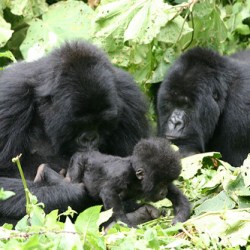Mountain Gorillas Are Amazing

There are only two places on Earth that mountain gorillas can be found. One of the places is known as Bwindi Impenetrable National Park in Uganda and the other is in Virunga Massif which is an area that spans the borders of Rwanda, DRC and Uganda. The area between Bwindi and Virunga is arguably one of the world’s most biologically diverse. Here you will find snow capped mountains touching base with African savannah. As a result, the wildlife variety found within both parks is massive including mountain gorillas who live at altitudes of between 1,500 to 4,000 metres above sea level.
Gorillas are big
A mature male silverback weighs anywhere between 140 to 180 kilograms and rather surprisingly the species diet consists mainly of leaves, shoots and stems. Whilst they do not eat a wide variety of food, they certainly do eat a huge quantity and spend more than half their time foraging for food. The lush green forests found on the slopes of the mountains are the perfect habitat for this amazing species.
Habitat encroachment is a problem
Unfortunately, there are more than 4 million people who live within walking distance of Virunga National Park. Due to human encroachment the mountain gorilla’s habitat is being degraded and used for charcoal production and agriculture and this is putting pressure on the species because the natural resources found in their natural habitats are being depleted. If we do not act to ensure that their habitat remains protected, we are in danger of losing the magnificent mountain gorilla in the wild.
Lots of similarities to humans
Whilst mountain gorillas may be double the size of the average human and covered in fur we are actually quite similar, sharing about 98 per cent of our DNA. As is the case with humans, mountain gorillas have unique identifiers. Whilst humans have fingerprints that are distinct, mountain gorillas have unique patterns on their noses. We also seem to prefer the same time of habitat with the type of landscape where you find mountain gorillas also having the highest densities of rural human populations.
Gorillas generate tourism revenue
The proximity of humans and mountain gorillas is fraught with potential threats to the well-being of the species including the potential for outbreak of disease, getting captured by snares and of course the ever-present danger of human-wildlife conflict. Whilst no animal has any concept of money, a wild mountain gorilla can actually generate about £2.5 million in revenue over its lifetime as a result of tourism. Thousands of people every year visit Rwanda’s Volcanoes National Park and over the last two decades, tourism revenue has increased dramatically.
We need to respect them
The money that has flowed has transformed the way government sees conservation. The work that conservation groups such as WWF and others do to support eco-tourism has helped to keep this wonderful species and their environment protected. They also provide jobs and other benefits to communities that live locally. The species is nothing like the sensationalised version depicted by the King Kong movies. They are calm and peaceful and it is important that we respect their natural behaviour and habitat by ensuring gorilla tourism is responsibly managed and limited to one group of tourists per day for no longer than one hour.



